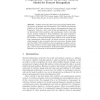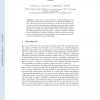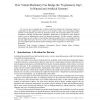SAB
2010
Springer
14 years 1 months ago
2010
Springer
Abstract. Rats and other whiskered mammals are capable of making sophisticated sensory discriminations using tactile signals from their facial whiskers (vibrissae). As part of a pr...
SAB
2010
Springer
14 years 1 months ago
2010
Springer
Abstract. Audition and touch endow spectral processing abilities allowing texture recognition and discrimination. Rat whiskers sensorisystem exhibits, as the cochlea, resonance pro...
SAB
2010
Springer
14 years 1 months ago
2010
Springer
The cerebellum plays a major role in motor control. It is thought to mediate the acquisition of forward and inverse internal models of the bodyenvironment interaction [1]. In this ...
SAB
2010
Springer
14 years 1 months ago
2010
Springer
Abstract. In this work, we are interested in understanding how emotional interactions with a social partner can bootstrap increasingly complex behaviors such as social referencing....
SAB
2010
Springer
14 years 1 months ago
2010
Springer
Reinforcement learning is one of the main adaptive mechanisms that is both well documented in animal behaviour and giving rise to computational studies in animats and robots. In th...
SAB
2010
Springer
14 years 1 months ago
2010
Springer
Prefrontal cortex (PFC) has been implicated in the ability to switch behavioral strategies in response to changes in reward contingencies. A recent experimental study has shown tha...
SAB
2010
Springer
14 years 1 months ago
2010
Springer
Abstract. Neurobiological studies showed the important role of Centeral Pattern Generators for spinal cord in the control and sensory feedback of animals' locomotion. In this ...
SAB
2010
Springer
14 years 2 months ago
2010
Springer
SAB
2010
Springer
14 years 2 months ago
2010
Springer
Learning robot-environment interaction with echo state networks (ESNs) is presented in this paper. ESNs are asked to bootstrap a robot’s control policy from human teacher’s dem...
SAB
2010
Springer
14 years 2 months ago
2010
Springer







